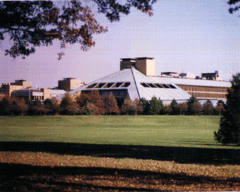How to manufacture creative success
 Magic and luck are two of the most pervasive explanations for poorly understood consequences. A third popular choice is money.When companies experience creative success, people are quick to look for explanations. After all: if we can understand what makes one movie a hit movie, couldn't we repeat it? "What was the budget?" we ask, and "where did they shoot it?" Or if it's a product, "what were the materials?" and "where was it manufactured?"Perhaps we should also be asking: "where was the creative work done?"The New York Times ran a feature in February about the incredible streak of innovation in Bell Labs in the mid-20th century. Bell Labs provided the transistor, the laser, the solar cell, and the CCD used in almost every digital camera today -- not too shabby.The Bell Labs building was in part designed by the Bell Labs chairman of the board, Mervin Kelley:
Magic and luck are two of the most pervasive explanations for poorly understood consequences. A third popular choice is money.When companies experience creative success, people are quick to look for explanations. After all: if we can understand what makes one movie a hit movie, couldn't we repeat it? "What was the budget?" we ask, and "where did they shoot it?" Or if it's a product, "what were the materials?" and "where was it manufactured?"Perhaps we should also be asking: "where was the creative work done?"The New York Times ran a feature in February about the incredible streak of innovation in Bell Labs in the mid-20th century. Bell Labs provided the transistor, the laser, the solar cell, and the CCD used in almost every digital camera today -- not too shabby.The Bell Labs building was in part designed by the Bell Labs chairman of the board, Mervin Kelley:
He personally helped design a building in Murray Hill, N.J., opened in 1941, where everyone would interact with one another. Some of the hallways in the building were designed to be so long that to look down their length was to see the end disappear at a vanishing point. Traveling the hall’s length without encountering a number of acquaintances, problems, diversions and ideas was almost impossible. A physicist on his way to lunch in the cafeteria was like a magnet rolling past iron filings.
In other words, he helped to design a building where it was nearly impossible to avoid everyone else working around you. And the people working around you were not all in your department, or even in your field of work. Engineers worked next to physicists who worked next to plant workers, so that no one group developed any sort of topical tunnel vision.Author Malcolm Gladwell's book The Tipping Point has quickly become an essential business book. More specifically, an essential business marketing book, because of how aptly it describes and categorizes the way human behavior and ideas pass through a social network.It turns out that humans can be "infected" with ideas - that the way these ideas spread through a network of humans is very similar to the way a virus will spread. And more importantly, that the results of those ideas will vary based on the context in which it is received.Humans are actually very sensitive to context. Gladwell cites a study indicating that criminal behavior is much more likely in neighborhoods that have broken windows. That's all it takes - if a neighborhood feels like a place where crime happens, then crime is more likely to happen there.Another well publicized example is the fact that people are more likely to jaywalk if they see someone else do it... and they're even more likely to follow suit (literally) if the person they see taking the lead appears to be someone with authority--because they're wearing a suit.This makes a lot of sense, since so much of communication is nonverbal. We like people better if they breath at the same rate we do, or if they're prettier. Two people having a conversation unconsciously modulate the speed of their speech to some average between where they both started.Humans are, without being aware of it, incredibly influenced by the non-obvious parts of our surroundings.Roughly a year after Bell Labs opened their doors, MIT hastily began construction on a much-needed wartime expansion of their Radiation Laboratory (a critical research location), creatively named "Building 20."Over the next fifty years, this funky, sprawling, "plywood palace" would be the home of an astounding amount of breakthrough research, including radar, the physics behind the microwave, and Noam Chomsky's famous work on linguistics.Can you guess what this building was like? According to John Lehrer writing in the New Yorker in January 2012, it was practically a maze. Rooms were bizarrely numbered -- third floor rooms included 201, 202, and second floor rooms were 101, 102. Wing E led to Wing D, Wing B to Wing A, and C was somewhere in the middle.Beyond the building's amazing ability to get even longtime residents lost, its lightweight construction meant that its occupants also felt free to modify the space to suit their needs: in one case, a researcher removed two floors in order to house a three-story atomic clock.Is it an accident that so much innovation comes from these "hot spots?" Or is there something to the science of context? It's not just who's together in a room, it's what room, and why. "The most creative spaces are those which hurl us together," says Lehrer at the end of his article, "It is the human friction that makes the sparks."Creating the right environment is perhaps the most overlooked challenge facing today's creative souls as they take aim at denting the future. Fortunately there exists an accidental (and purposeful) history of success: both Building 20 and Bell Labs featured hallways that forced people to walk in circuitous routes. Both buildings housed people working in entirely different fields so that when people ran in to one another they weren't just talking to people who spend all day thinking about the same subjects.Even if you're not constructing and laying out your own buildings, you can focus on placing groups of people near other groups in entirely different departments. Bell Labs intentionally housed manufacturing personnel alongside the physicists who worked almost entirely in numbers. Design teams can (and should) be next to sales and engineering teams. You could strategically close certain sets of restrooms so that people are forced to walk the hallways of other departments with regularity.[As an aside: it's important to note that this is not the same as an open floor plan, which can have it's own set of drawbacks. The goal is balance: randomness, but without sacrificing the ability to focus. Personal work spaces that you're forced to leave.]It boils down to this: humans are creative in diverse groups by nature, but are by nature averse to diverse groups. The best creative spaces have a surprisingly large contribution to make to the end product by forcing people to make connections they would not otherwise have discovered.
